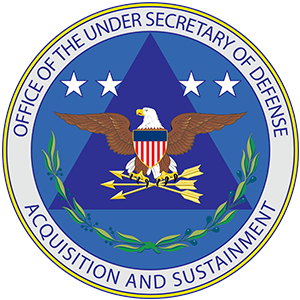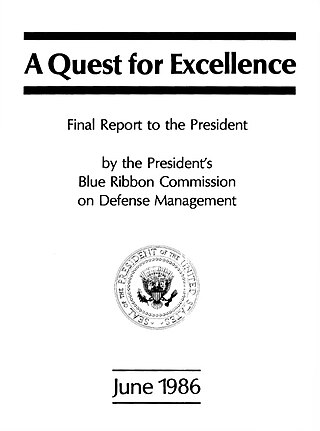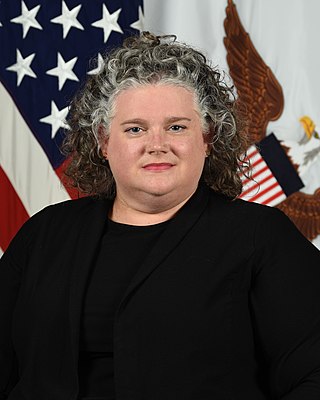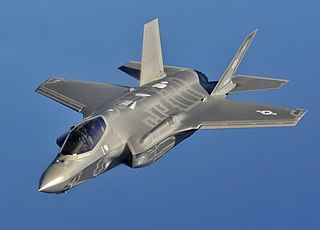
Edward "Pete" Cleveland Aldridge Jr. is an aerospace engineer and former government official in the U.S. Defense Department. He was also selected as a payload specialist for the Space Shuttle mission STS-62-A, scheduled to launch in July 1986. The mission was canceled after the Space Shuttle Challenger disaster in January 1986, and Aldridge never flew.
A United States defense standard, often called a military standard, "MIL-STD", "MIL-SPEC", or (informally) "MilSpecs", is used to help achieve standardization objectives by the U.S. Department of Defense.

The Office of the Secretary of Defense (OSD) is a headquarters-level staff of the United States Department of Defense. It is the principal civilian staff element of the U.S. Secretary of Defense, and it assists the Secretary in carrying out authority, direction and control of the Department of Defense in the exercise of policy development, planning, resource management, fiscal, and program evaluation responsibilities. OSD is the Secretary of Defense's support staff for managing the Department of Defense, and it corresponds to what the Executive Office of the President of the U.S. is to the U.S. president for managing the whole of the Executive branch of the federal government.

The Lockheed Martin VH-71 Kestrel was a variant of the AgustaWestland AW101 that was being manufactured to replace the United States Marine Corps' Marine One U.S. Presidential transport fleet. Originally marketed for various competitions as the US101, it was developed and manufactured in the US by a consortium headed by Lockheed Martin, consisting of Lockheed Martin Systems Integration – Owego (LMSI), AgustaWestland and Bell Helicopter.
The Information Technology Management Reform Act of 1996 is a United States federal law, designed to improve the way the federal government acquires, uses and disposes information technology (IT). It was passed as Division E of the National Defense Authorization Act for Fiscal Year 1996. Together with the Federal Acquisition Reform Act of 1996, it is known as the Clinger–Cohen Act.

The under secretary of defense for intelligence and security or USD(I&S) is a high-ranking civilian position in the Office of the Secretary of Defense (OSD) within the U.S. Department of Defense (DoD) that acts as the principal civilian advisor and deputy to the secretary of defense (SecDef) and deputy secretary of defense (DepSecDef) on matters relating to military intelligence and security. The under secretary is appointed as a civilian by the president and confirmed by the Senate to serve at the pleasure of the president.

Located at Kirtland Air Force Base, New Mexico, the Air Force Operational Test and Evaluation Center is a direct reporting unit of Headquarters, United States Air Force. It is the Air Force independent test agency responsible for testing, under operationally realistic conditions, new systems being developed for Air Force and multi-service use.

The Under Secretary of Defense for Acquisition and Sustainment, or USD(A&S), is the Principal Staff Assistant (PSA) and advisor to the Secretary of Defense for all matters relating to acquisition and sustainment in the Department of Defense. This includes the DoD Acquisition System; system design and development; production; logistics and distribution; installation maintenance, management, and resilience; military construction; procurement of goods and services; material readiness; maintenance; environment and energy resilience ; utilities; business management modernization; International Armaments Cooperation, Cooperative Acquisition and International Agreements, Promoting exportability of military components to allies and partners; nuclear, chemical and biological defense programs; and nuclear command, control, and communications.

The President's Blue Ribbon Commission on Defense Management, informally known as the Packard Commission, was a federal government commission by President Ronald Reagan, created by Executive Order 12526 to study several areas of management functionality within the US Department of Defense. The commission was chaired by David Packard.

The Director of Cost Assessment and Program Evaluation (CAPE) is a principal staff assistant and advisor to the Secretary and Deputy Secretary of Defense in the Office of the Secretary of Defense.

Focal plane array testing is a specialized field of test engineering. Focal plane array (FPA) imaging devices are used in missile guidance sensors, infrared astronomy, manufacturing inspection, and thermal imaging. Focal plane array testing is the process of verifying and validating that these devices function correctly. Focal plane arrays are complex to develop, in some cases the fabrication process may have more than 150 steps, testing of these devices must ensure that each step has the desired result.

William James Lynn III is a former United States Deputy Secretary of Defense. Before that he was Under Secretary of Defense (Comptroller) and a lobbyist for Raytheon.

Military acquisition or defense acquisition is the "bureaucratic management and procurement process", dealing with a nation's investments in the technologies, programs, and product support necessary to achieve its national security strategy and support its armed forces. Its objective is to acquire products that satisfy specified needs and provide measurable improvement to mission capability at a fair and reasonable price.

Jamie Michael Morin is a former senior official in the United States Department of Defense. He was a private sector economist and research consultant before earning a Doctorate degree in political science from Yale University. He then served as a professional staff member on the United States Senate Committee on the Budget. Morin was Director of Cost Assessment and Program Evaluation at the Department of Defense. Previously, he was Assistant Secretary of the Air Force, and served concurrently as Acting Under Secretary of the Air Force from 3 July 2012 to 28 April 2013. He joined The Aerospace Corporation in 2017 as executive director of the Center for Space Policy and Strategy and vice president of Defense Systems Operations.

The Under Secretary of Defense for Research and Engineering, abbreviated USD (R&E), is a senior official of the United States Department of Defense. The USD (R&E) is charged with the development and oversight of technology strategy for the DoD. The post has at various times had the titles Assistant Secretary of Defense for Research and Engineering, or Director of Defense Research and Engineering (DDR&E). The latter title has itself historically varied between the rank of under secretary and that of assistant secretary.

Robert Clifton "Cliff" Duncan was an American engineer and engineering manager, particularly for the US Government. He is best known for two of the programs he directed to a successful completion - guidance and control for Apollo program, and the Polaroid SX-70 camera.

The Assistant Secretary of Defense for Nuclear, Chemical & Biological Defense Programs, or ASD(NCB), is the principal adviser to the Secretary of Defense, Deputy Secretary of Defense and the Under Secretary of Defense for Acquisition and Sustainment on policy and plans for nuclear, chemical, and biological defense programs.

Lockheed Martin F-35 Lightning II development started in 1995 with the origins of the Joint Strike Fighter program and culminated in the completion of operational testing and start of full-rate production in 2021. The X-35 first flew on 24 October 2000 and the F-35A on 15 December 2006.

The United States Army Acquisition Corps (AAC) is the officer / NCO corps of the United States Army Acquisition Workforce (AAW), a branch which includes civilians, officers, and NCOs. The Acquisition Corps is composed of army officers who serve in acquisition, a specialized form of product development, fielding, and support and Noncommissioned Officers who specialize in Contracting, Level I Program Management and Purchasing. These officers begin their careers in the other branches of the army for eight years, after which they may elect the Acquisition branch as their career as assistant program managers (APMs), program managers (PMs), and program executive officers (PEOs). The Noncommissioned Officers (NCOs) are reclassified in the Army Acquisition NCO Corps after serving 7-10 years in their respective enlisted career management fields, and serve primarily in the Army Acquisition Career Management Field - 51 and (MOS) 51C. 4% percentage of the Army Acquisition Officers serve among the 40,000 members of the army acquisition workforce, 6% in MOS 51C - Acquisition, Logistics and Technology Contracting Noncommissioned Officer, and the remainder 90% percentage consist largely of Department of the Army civilians.

Donna D. Shipton is a United States Air Force lieutenant general who serves as commander of the Air Force Life Cycle Management Center. The center is responsible for total life cycle management for aircraft, engines, munitions, electronic, computer, network, cyber and agile combat support systems. The center employs more than 28,000 people and has a budget of over $300 billion. Previously she served as military deputy to the Assistant Secretary of the Air Force for Acquisition, Technology and Logistics.


















